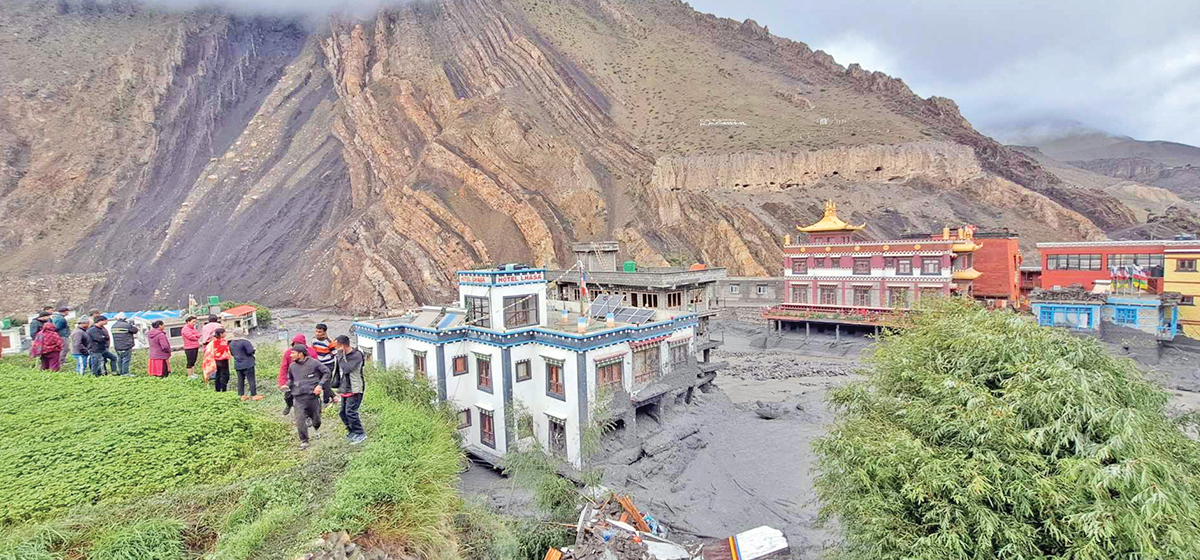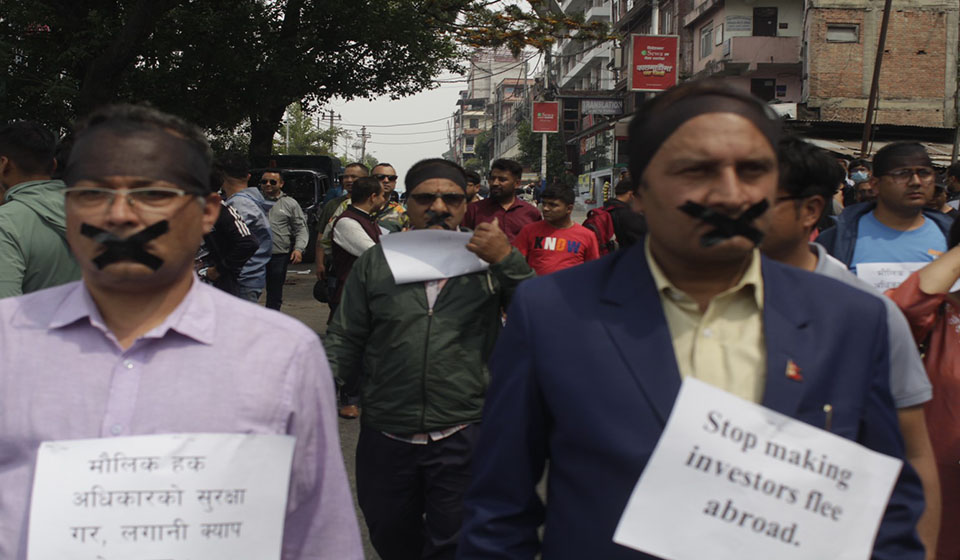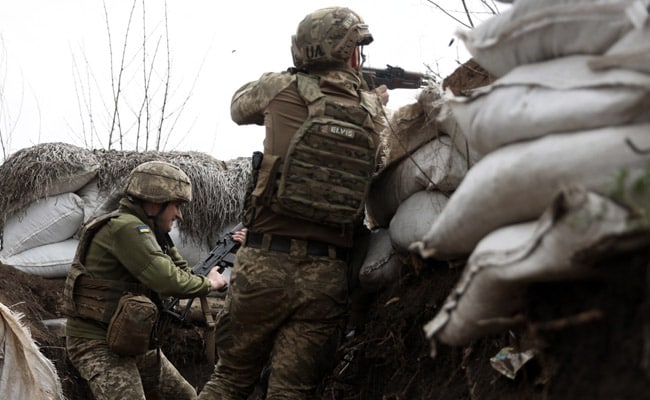
OR
What caused the unprecedented flood in Mustang?
Published On: August 15, 2023 01:30 PM NPT By: SHREE RAM SUBEDI

KATHMANDU, Aug 15: Mustang and Manang, regions known for their rain shadow status due to limited rainfall, have been grappling with an unexpected surge in heavy rains and subsequent floods. This perplexing occurrence has prompted experts to delve into the underlying causes, sparking debates over whether it is linked to a climate crisis or other factors.
The recent flood that struck Kagbeni, a vital religious and tourist destination en route to the renowned Muktinath temple in Mustang, further spotlighted this perplexing issue. The incident, which unfolded on a Sunday night, caused significant destruction, demolishing 31 structures including houses, hotels, temples, ashrams, schools, and police stations along the path from Muktinath to Kagkhola.
Notably, the region's unusual vulnerability to floods echoes memories of the devastation caused by the Melamchi flood two years prior. While the village of Kagbeni was ravaged by the torrents of a typically modest river, the calamity underscores the rarity and gravity of the situation.
Bikal Gurung, a local who live-streamed the event on TikTok, described the incident as a "tragic and uncommon occurrence." Despite prompt information dissemination that averted human casualties, the true extent of economic damage from the deluge is still being assessed.
Mustang and Manang, nestled amidst towering mountains that typically shield them from excessive rain, have experienced a surge in heavy downpours and floods in recent years. Nearby Manang district faced significant destruction from heavy rainfall two years ago, amplifying concerns about the changing weather patterns in the region.
The Department of Hydrology and Meteorology reported that the area had received 25 mm of rain in the 24 hours leading up to the flood — a record-breaking figure for the region. The department's Flood Forecasting Division bulletin explained that landslides in the upper coastal area obstructed Kagkhola, causing water accumulation that eventually burst, triggering an unexpected torrent of debris and floodwater.
While no conclusive evidence currently exists to pinpoint the exact cause of this trend, experts offer varying perspectives. Dr Basanta Adhikari, a disaster specialist, noted that the phenomenon might not be directly linked to climate change but emphasized the rarity of such occurrences. He highlighted that Mustang's soft soil struggles to absorb heavy rainfall, resulting in potential erosion and damage.
Climate scientist Arun Bhakta Shrestha from ICIMOD agreed, characterizing the event as an abnormal phenomenon. He remarked, "Experiencing such significant rainfall in a rain shadow area cannot be considered normal."
Conversely, climatologist Namindra Dahal attributed the escalating rainfall to global temperature rise. He explained that as atmospheric temperatures increase, they push monsoon air upwards, leading to heightened cloud formations that traverse mountains, causing intense precipitation. The earth's temperature has risen by 1.2 degrees compared to pre-industrial levels, with more pronounced impacts on the Himalayan region.
Dahal cited a study published in the journal Nature, revealing that every degree Celsius rise in temperature increases the likelihood of extreme rainfall in high mountain regions by 15 percent. Computer simulations analyzing rainfall and snow data since 1950 reinforce this prognosis, suggesting that heavy rainfall, rather than snow accumulation, is the primary driver of floods, landslides, and soil erosion in highlands.
What to do now?
Dr Adhikari underscores the necessity of conducting a comprehensive study to determine the vulnerable zones within high mountain regions that are susceptible to heavy rains and flooding. Expressing concern over the government's lax enforcement of the national land use policy and corresponding mapping, he stresses the need for an immediate moratorium on constructing buildings along flood-prone riverbanks.
The recently issued National Framework for Climate-related Damage-2021 by the Government of Nepal underscores the importance of factoring in potential disaster risks in development initiatives, urban planning, and settlement expansion. Dr. Bimal Regmi, a climate expert, emphasizes that proactive and transformative adaptation strategies are crucial for safeguarding both human lives and infrastructure from potential future scenarios. Regmi firmly advocates that no development endeavors should proceed without thorough risk mapping.
Similarly, environmental advocate Dr Shailendra Thakali, a resident of Jomsom, reflects on the poignant lesson gleaned from the flooding of Krishna Sagar in Kagkhola, also known as Muktinath Khola. He asserts that despite calls for climate-intelligent policies and sustainable development practices, the on-ground implementation at the local level remains inadequate. Dr Thakali highlights that until decisive action is taken to rectify this hesitation, the cycle of tragic occurrences, like the recent flood, is likely to persist. He aptly states, "The perpetuation of such devastating events will persist as long as this cautious approach prevails."
You May Like This

Mustang disaster- A wake up call
The unexpected surge in heavy rainfall and subsequent floods in the traditionally arid regions of Mustang and Manang in recent... Read More...

FLOOD ALERT: Chure, Mahabharat range likely to experience flood and landslides
KATHMANDU, July 1: Through a notice, the Department of Hydrology and Meteorology has issued an early warning notice urging residents... Read More...

It was landslide dam outburst flood: ICIMOD expert
KATHMANDU, July 8: An expert with the International Center for Integrated Mountain Development (ICIMOD) has said Tuesday night's flash flood... Read More...


Just In
- NEA schedules five-day power cut across Kathmandu Valley for underground cable installation
- Hundreds of passengers including foreign tourists in distress as poor visibility halts flights to and from PRIA
- Nepal clinches thrilling victory over West Indies 'A' in T20 cricket match
- Capital Market Struggle Committee stages protest demanding protection of domestic investors (Photo Feature)
- Captain Paudel scores half-century in T20 match against West Indies 'A'
- Nine youths from Tanahu allegedly joining Russian army out of family contact for months
- West Indies 'A' sets Nepal a target of 205 runs
- Parliamentary committee directs govt to provide electricity tariff subsidies to cold storage facilities










-1200x560-wm_20240427144118.jpg)





Leave A Comment